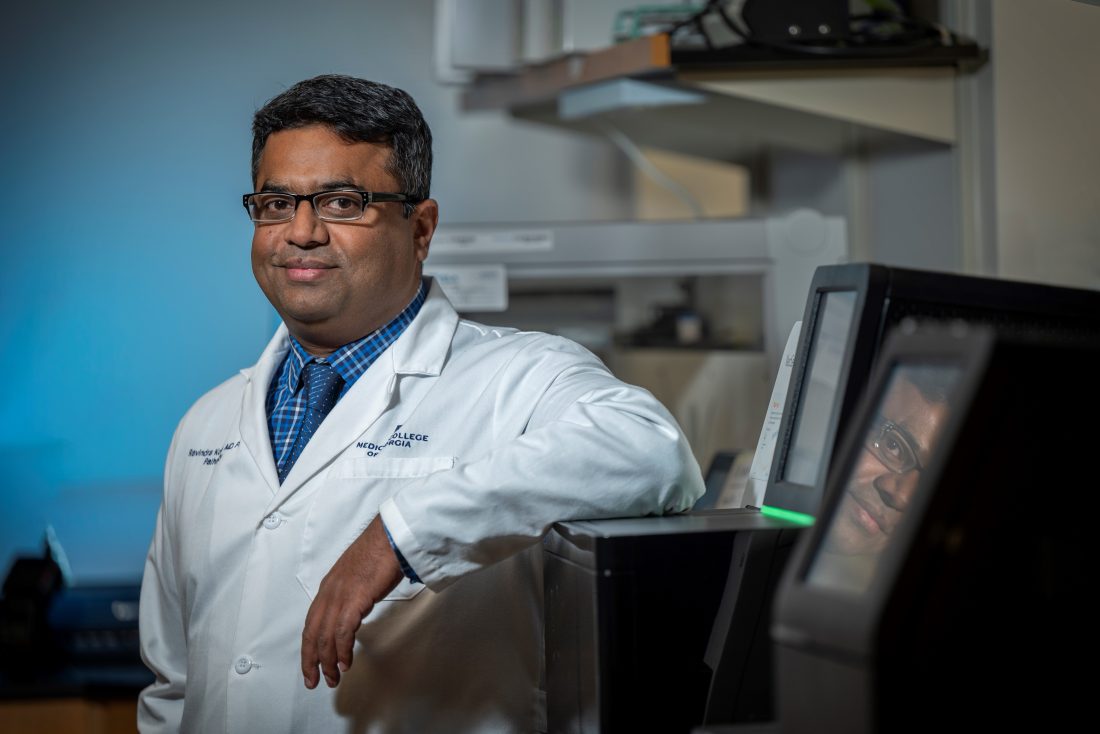Technology that enables an unprecedented, high-resolution look for all structural variants in our genes that are known to cause cancer can outperform standard tests used today for common blood cancers like leukemia, researchers report.
It’s called optical genome mapping, or OGM, a longtime research tool now making its way into health care.
Now the first study to standardize precisely how to use OGM for patients with a wide range of blood cancers indicates it can duplicate what existing tests find, provide better insight on the variants those tests identify and find additional variants, information that should improve patient outcomes.
“This is the first study to try to standardize the way we need to investigate these structural changes in hematologic malignancies using OGM for patients,” says Ravindra Kolhe, MD, PhD, molecular pathologist and interim chair of the Department of Pathology at the Medical College of Georgia at Augusta University.
“The bottom line is that by using technology like this, we will be able to make a better, more specific diagnosis, better classify the cancer, give a better prognosis based on that classification and enable better therapy choices,“ says Kolhe, corresponding author of the study published in The Journal of Molecular Diagnostics.
The findings demonstrate OGM’s potential as a frontline test in diagnosing blood cancers, or hematologic malignancies, says Kolhe, associate director of genomics at the Georgia Cancer Center. Often, more than one of the three current tests are done on a single patient, and OGM may eliminate the need for multiple tests, the investigators say.
OGM enables a direct look at DNA that, as the technology’s name implies, provides a perspective that is 20,000 times closer than conventional, commonly used karyotyping. Karyotyping, which looks for chromosomal abnormalities, is one of the techniques used to analyze blood cancers. Others include chromosomal microarray, which looks for genetic deletions or duplications at a higher resolution than karyotyping but nowhere near that of OGM; and fluorescence in situ hybridization, or FISH, which also looks directly at DNA but on a much smaller, and less high-resolution scale, than OGM.
A key problem has been the comparatively low resolution of the technologies, which Kolhe likens to looking at the sky with the naked eye.
“This what is known as whole genome mapping,” says Kolhe. “This looks genome-wide for structural variants.”
DNA is a fundamental unit of our genetic material that makes us, genes are segments of our DNA and DNA is carried in chromosomes which are found in our cells. It’s a patient’s symptoms and a typically subsequent look at cells in their blood that first indicate cancer is present. But it’s these structural variants in the genes in those cells that are a major cause of cancer and can tell you the specific cancer type and stage, Kolhe says.
Structural variations, which can alter the gene’s normal function into a cancer-promoting mechanism, include things like duplication or deletion of a gene and two genes swapping places in a process called translocation which, for example, might make the gene more active. Genes can even “fall out,” which can be problematic if, for example, one of those genes is a natural tumor suppressor like the p53 gene.
Kolhe notes his frustration over the years at looking at the findings of low-resolution techniques like karyotyping that have prevented identification of specific structural variants.
As an example, with today’s standard technologies, pathologists have a category called “karyotypically normal leukemia,” a true oxymoron, he says, because there are clearly one or more abnormalities causing the cancer but the pathologists looking for them cannot see them and/or cannot see them well.
Kolhe and colleagues at MCG, Emory University’s Department of Pathology and San Diego-based Bionano Genomics Inc., which developed an OGM system called Saphyr, decided to look at how to standardize OGM’s use in analyzing a wide range of blood cancers and see how its findings stack up to current methods.
They looked at 59 samples of blood, isolated cells and lymph nodes and bone marrow, some of them multiple times for the purpose of validation. The patients had a variety of common blood cancers, such as chronic lymphocytic leukemia and lymphoma, and there were 10 control samples from individuals without cancer. One or more of the standard tests had been performed on each patient’s samples including 10 leukemia samples that were classified normal by karyotyping, 45 classified as simple cases, meaning there were less than four structural variants found, and 14 as complex with four or more variants.
As examples of what OGM found, it confirmed all but two of the 164 variants found by traditional methods. But in the 10 leukemia samples that were classified as normal by karyotyping, structural variations were detected in 40% by OGM. Seven of the samples that were classified as simple by both FISH and karyotyping were found to have four or more aberrations, which would classify the cancers as complex. Five of the seven samples classified as simple based on just FISH testing, showed four or more aberrations with OGM, and OGM was able to further delineate some individual variants in both these groups. For example, in chronic lymphocytic leukemia, OGM was able to distinguish minute changes in common deletions associated with the cancer that moved the prognosis from good to poor. It was also able to detect 106 novel gene fusions. Gene fusions are when a new gene results from joining parts of two different genes, which may lead to developing some cancer types, according to the National Cancer Institute. Current techniques like FISH are not proficient at identifying new gene fusions.
Kolhe notes use of OGM should result in about 20% of patients at least getting a change in the classification of their malignancy, say from low- to mild-risk, which makes a difference in treatment choices. These more refined diagnoses are needed to make optimal use of the unprecedented numbers of targeted treatment options today, he notes.
“Our first goal was to confirm those abnormalities with this technique,” Kolhe says. “On top of that, we showed optical genome mapping adds a substantial layer of clinically relevant information about that patient.”
The standardization of the technique was necessary to establish precisely how to use OGM on patients to obtain consistently, accurate results.
Other investigators also have been exploring OGM’s potential in specific cancers like acute lymphoblastic leukemias and larger groups of cancer types as well.
There already is some movement in places like Europe and Canada to move away from longtime approaches like FISH and move toward OGM. Kolhe hopes the newly published information about how to use OGM for patients will help do the same in this country.
Later this month, the Georgia Cancer Center will be the first to use OGM for patient care in the United States, Kolhe says. While many centers do not have the OGM technology, providers can send their patients’ cells to MCG’s Georgia Esoteric and Molecular Lab for testing effectively immediately.
There are structural variants you can be born with, which are responsible for genetic disorders, or you can acquire them through environmental exposures like cigarette smoke or obesity.
Read the full study.
 Augusta University
Augusta University




